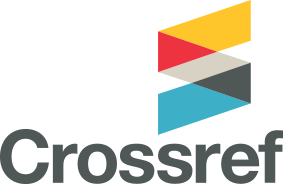Identifikasi Sifat-Sifat Produksi Persilangan Babi Duroc ean Yokshire
Abstract
Penelitian dilakukan di peternakan babi PT Fajar Semesta Indah di Singkawang Kalimantan Barat. Penelitian bertujuan untuk mengetahui performans produksi pada babi Duroc, Yorkshire serta persilangannya. Materi yang digunakan dalam penelitian ini bangsa babi Yorkshire, Duroc, persilangan Yorkshire-Duroc serta persilangan Duroc- Yorkshire dengan jumlah masing-masing 197 ekor; 264 ekor; 168 ekor dan 275 ekor. Metode yang digunakan dalam penelitian ini adalah pengamatan dan pengukuran langsung pada ternak babi dengan menggunakan data primer. Penentuan sample menggunakan purposive sampling. Variabel yang diamati adalah litter size, berat lahir, berat sapih dan mortalitas anak babi prasapih. Untuk mengetahui pengaruh bangsa terhadap sifat produksi digunakan analisis ragam Rancangan Acak Lengkap. Hasil penelitian menunjukkan rataan litter size, berat lahir dan berat sapih anak babi masing-masing pada bangsa babi Yorkshire (9,38±2,87 ekor; 1,24±0,25 kg dan 6,73±0,71 kg), Duroc (8,41±3,26 ekor; 1,23±0,26 kg dan 6,54±1,07 kg); babi persilangan Yorkshire-Duroc (9,88±3,04 ekor; 1,26±0,36 kg dan 6,84±0,78 kg) serta persilangan Duroc-Yorkshire (9,48±2,63 ekor; 1,28±0,26 kg dan 6,91±0,86 kg). Laju kematian anak prasapih secara berturut turut yaitu pada babi persilangan Yorkshire-Duroc sebesar 17,85 persen; Yorkshire sebesar 15,74 persen; Duroc 13,64 persen serta persilangan Duroc-Yorkshire sebesar 11,64 persen. Disimpulkan sistem perkawinan antar bangsa babi tidak berpengaruh terhadap litter size dan berat lahir tetapi berpengaruh sangat nyata (P<0,01) terhadap berat sapih anak babi. Disarankan untuk meningkatkan produktivitas babi di PT Fajar Indah Semesta sebaiknya melakukan perkawinan silang.
Keywords
References
Akdag, F., Arslan, S., & Demir, H. (2009). The effect of parity and litter size on birth weight and the effect of birth weight variations on weaning weight and pre-weaning survival in piglet. Journal of Animal and Veterinary Advances, 8(11), 2133–2138.
Aritonang, D., & Silalahi, M. (2001). Produktivitas berbagai galur babi ras impor selama periode laktasi. Jurnal Ilmu Ternak Dan Veteriner, 6(1).
Barreras, A., Haro, J. G. H., Hori-Oshima, S., Espinosa, G., Cerrilla, E. O., Pérez, J. P., Avila, G. S. (2009). Prolactin receptor (PRLR) gen polymorphism and associations with reproductive traits in pigs. Journal of Animal and Veterinary Advances, 8(3), 469–475.
Dube, B., Sendros, D., Mulugeta, & Dzama, K. (2012). Estimation of genetic and phenotypic parameters for sow productivity traits in South African Large White pigs. South African Journal of Animal Science, 42(4), 389–397.
Einarsson, S., Brandt, Y., Lundeheim, N., & Madej, A. (2008). Stress and its influence on reproduction in pigs: a review. Acta Vet Scand, 50(1), 1–8.
Hakim, L. (2001). Dasar Pemuliaan Ternak. Malang: Fakultas Peternakan Universitas Brawijaya.
Janse van Rensburg, L., & Spencer, B. T. (2014). The influence of environmental temperatures on farrowing rates and litter sizes in South African pig breeding units. Onderstepoort J Vet Res, 81(1), 1–7. https://doi.org/10.4102/ojvr.v81i1.824
Johnson, Z. B., & Nugent, R. (2006). Prediction of Number Born Alive and Weaning Weight of Litter in First Parity Sows Using Performance Test Traits in Four Breeds of Swine. Arkansas Animal Science Department Report.
Kantanamalakul, C., Sopannarath, P., & Tumwasorn, S. (2007). Estimation of breed effects on litter traits at birth in yorkshire and landrace pigs. Walailak J Sci & Tech, 4(2), 175–186.
Knecht, D., Środoń, S., Szulc, K., & Duziński, K. (2013). The effect of photoperiod on selected parameters of boar semen. Livestock Science, 157(1), 364–371. https://doi.org/10.1016/J.LIVSCI.2013.06.027
Kongsted, A., Claudi-Magnussen, C., Hermansen, J., & Andersen, B. (2008). Strategies for a diversified organic pork production (16th ed.). Modena, Italy: Proceedings IFOAM Organic World Congress.
Lee, J.-H., Song, K.-D., Lee, H.-K., Cho, K.-H., Park, H.-C., & Park, K.-D. (2015). Genetic parameters of reproductive and meat quality traits in korean berkshire pigs. Asian-Australasian Journal of Animal Sciences, 28(10), 1388–1393. https://doi.org/10.5713/ajas.15.0097
Lukac, D., & Vidovic, V. (2013). Parameters of genetic and phenotypic type in pigs mating in pure breed and crossbreeding on litter size. Afr J Agric Res, 8(37), 4664–4669.
Maylinda, S. (2010). Pengantar Pemuliaan Ternak. Malang: Universitas Brawijaya Press.
Mondal, S. K., Kumar, A., Dubey, P. P., Sivamani, B., & Dutt, T. (2014). Estimation of variance and genetic parameters for pre-weaning weights of individual Landrace X Desi synthetic piglets. Journal of Applied Animal Research, 42(3), 338–344. https://doi.org/10.1080/09712119.2013.875901
Nienaber, J., & Hahn, G. (2007). Livestock production system management responses to thermal challenges. Int J Biomet, 52, 149–157.
Parakkasi, A. (2006). Ilmu dan Makanan Ternak Monogastrik. Bandung: Angkasa.
Pardosi, U. (2004). Pengaruh Perkawinan Antara Tiga Bangsa Babi terhadap Prestasi Anak dari Lahir sampai dengan Sapih di PT. Mabarindo Sumbul Multifarm (Tesis). Semarang: Program Pascasarjana Universitas Diponegoro.
Paura, L., Jonkus, D., & Permanickis, U. (2014). Genetic parameters and genetic gain for the reproduction traits in latvian landrace and yorkshire sows populations. Animal and Veterinary Sciences, 2(6), 184–188. https://doi.org/10.11648/j.avs.20140206.15
Thompson, J. E., Gill, B. P., & Varley, M. A. (2004). The Appliance of Pig Science. Hampshire: Nottingham University Press.
Publication ID
DOI https://doi.org/10.21776/ub.jtapro.2019.020.01.7Refbacks
- There are currently no refbacks.

This work is licensed under a Creative Commons Attribution-NonCommercial 4.0 International License.










